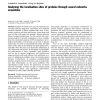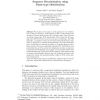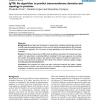151 search results - page 19 / 31 » Classifying protein sequences using hydropathy blocks |
NCA
2006
IEEE
13 years 7 months ago
2006
IEEE
Scientists involved in the area of proteomics are currently seeking integrated, customised and validated research solutions to better expedite their work in proteomics analyses and...
BMCBI
2004
13 years 7 months ago
2004
Background: G protein-coupled receptors (GPCRs) transduce signals from extracellular space into the cell, through their interaction with G proteins, which act as switches forming ...
ECML
2006
Springer
13 years 11 months ago
2006
Springer
Abstract We propose in this paper a novel approach to the classification of discrete sequences. This approach builds a model fitting some dynamical features deduced from the learni...
BMCBI
2008
13 years 7 months ago
2008
Background: Due to their role of receptors or transporters, membrane proteins play a key role in many important biological functions. In our work we used Grammatical Inference (GI...
BMCBI
2002
13 years 7 months ago
2002
Background: Total sequence decomposition, using the web-based MASIA tool, identifies areas of conservation in aligned protein sequences. By structurally annotating these motifs, t...



